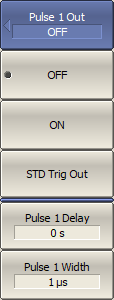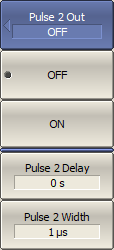Selecting the Pulse Measurement Mode
|
To turn the pulse measurement ON, use the following softkeys: Stimulus > Pulse Meas > Pulse Meas [ON | OFF] |
|
To select a pulse measurement mode, use the following softkeys: Stimulus > Pulse Meas > Pulse Mode [Point-in-Pulse | Pulse Profile | Asynchronous] Where: •Point-in-Pulse — measurement of S-parameters of impulse devices in the frequency domain using broadband detection. •Pulse Profile — measurement of the pulse envelope in the time domain during the one pulse width. •Asynchronous — measurement of S-parameters of impulse devices in the frequency domain using narrowband detection. |
|
|
Point-in-Pulse and Pulse Profile Settings
|
To select a pulse trigger source, use the following softkeys: Stimulus > Pulse Meas > Pulse Trigger [Internal | External] |
|
To enable the “Ready for Pulse” signal at the “Pulse 1 Out” BNC connector, use the following softkeys: Stimulus > Pulse Meas > Ready for Pulse [ON | OFF] Where: •ON — enables “Ready for Pulse” signal connected to "Pulse 1 Out". •OFF — disables “Ready for Pulse” signal. |
|
|
note |
If the “Ready for Pulse” signal is not used, ensure that the period of the external trigger pulses does not exceed the sum of the modulating pulse width and the setup time of the Analyzer's synthesizers when switching to the next frequency. |
|
To set the parameters of the modulating pulse train, use the following softkeys: |
|
•Pulse repetition period when the internal Pulse Trigger source is used: Stimulus > Pulse Meas > Pulse Period |
|
•Modulation pulse delay: Stimulus > Pulse Meas > Pulse Delay |
|
•Modulation pulse width: Stimulus > Pulse Meas > Pulse Width |
|
•Data acquisition start delay. Acts for the point-in-pulse and pulse profile modes: Stimulus > Pulse Meas > Acquisition Delay |
|
•Data acquisition pulse width: Stimulus > Pulse Meas > Acquisition Width |
|
•Pulse profile time: Stimulus > Pulse Meas > Profile Time |
|
If the Ready for Pulse function is not used, the BNC connector "Pulse 1 Out" can be assigned as follows: Stimulus > Pulse Meas > Pulse 1 Out > {OFF | ON | STD Trig Out} Where: •OFF — connector is not used. •ON — puts out the internal generator “Pulse 1” signal. •STD Trig Out — "Pulse 1 Out" operates according to the trigger settings for standard measurements (Stimulus > Trigger > Trigger Output). To set the parameters of the internal generator "Pulse 1", use the following softkeys: •Pulse 1 delay: Stimulus > Pulse Meas > Pulse 1 Out > Pulse 1 Delay •Pulse 1 width: Stimulus > Pulse Meas > Pulse 1 Out > Pulse 1 Width |
|
If the external trigger is not used, the BNC connector "Pulse 2 In/Out" can be assigned as follows: Stimulus > Pulse Meas > Pulse 2 Out > {OFF | ON} Where: •OFF — connector is not used. •ON — puts out the internal generator “Pulse 2” signal. To set the parameters of the internal generator "Pulse 2", use the following softkeys: •Pulse 2 delay: Stimulus > Pulse Meas > Pulse 2 Out > Pulse 2 Delay •Pulse 2 width: Stimulus > Pulse Meas > Pulse 2 Out > Pulse 2 Width |
|
|
If Asynchronous Measurement Method is Selected:
•The moment the measurement starts is not synchronized with the modulation pulses.
•Internal generators of the Analyzer are not used. The Analyzer is operating in the standard mode.
•Modulation pulses are fed from an external generator directly to the control input of the internal modulator.
•For successful signal detection, the measurement width (IF filter) must be more than 10 times the pulse repetition period.
|
Select the pulse source for the asynchronous mode using the softkeys: Stimulus > Pulse Meas > Async Pulse > [External | Internal] |
|
The internal modulator can be turned off in the asynchronous mode. The modulator is always turned on in synchronous mode. There is a continuous stimulus at the analyzer port if the modulator is turned off. To turn off the modulator in the asynchronous mode, use the following softkeys: Stimulus > Pulse Meas > Internal Modulator {OFF | ON} |
|
In case of using an internal generator, set the parameters of the modulating pulse sequence using the softkeys: |
|
•Pulse repetition period: Stimulus > Pulse Meas > Pulse Period |
|
•Pulse modulation width: Stimulus > Pulse Meas > Pulse Width |
|
|














